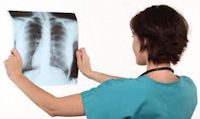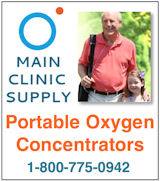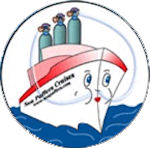About Emphysema and Lung Diseases
 The lung disease Emphysema is defined pathologically as an abnormal permanent enlargement of air spaces distal to the terminal bronchioles, accompanied by the destruction of alveolar walls and without obvious fibrosis. Emphysema frequently occurs in association with chronic bronchitis. These 2 entities have been traditionally grouped under the umbrella term COPD. Patients have been classified as having COPD with either emphysema or chronic bronchitis predominance.
The lung disease Emphysema is defined pathologically as an abnormal permanent enlargement of air spaces distal to the terminal bronchioles, accompanied by the destruction of alveolar walls and without obvious fibrosis. Emphysema frequently occurs in association with chronic bronchitis. These 2 entities have been traditionally grouped under the umbrella term COPD. Patients have been classified as having COPD with either emphysema or chronic bronchitis predominance.
Three described morphological types of emphysema
Centriacinar emphysema begins in the respiratory bronchioles and spreads peripherally. Also termed centrilobular emphysema, this form is associated with long-standing cigarette smoking and predominantly involves the upper half of the lungs.
Panacinar emphysema destroys the entire alveolus uniformly and is predominant in the lower half of the lungs. Panacinar emphysema generally is observed in patients with homozygous alpha1-antitrypsin (AAT) deficiency. In people who smoke, focal panacinar emphysema at the lung bases may accompany centriacinar emphysema.
Paraseptal emphysema, also known as distal acinar emphysema, preferentially involves the distal airway structures, alveolar ducts, and alveolar sacs. The process is localized around the septae of the lungs or pleura. Although airflow frequently is preserved, the apical bullae may lead to spontaneous pneumothorax. Giant bullae occasionally cause severe compression of adjacent lung tissue.
Treatment of Emphysema
The goal of therapy for emphysema is to provide relief of symptoms, prevent complications and slow the progression of the disease. The best treaatment for emphysema is quit smoking. This is essential for patients with emphysema, since continuing to use tobacco will only further damage the lungs.
Emphysema Medications
Bronchodilator Medications
Inhaled as aerosol sprays or taken orally, bronchodilator medications may help to relieve symptoms of emphysema by relaxing and opening the air passages in the lungs.
Steroids
Inhaled as an aerosol spray, steroids can help relieve symptoms of emphysema associated with asthma and bronchitis. Over time, however, inhaled steroids can cause side effects, such as weakened bones, high blood pressure, diabetes and cataracts. It is important to discuss these side effects with your doctor before using steroids.
Antibiotics
Antibiotics may be used to help fight respiratory infections common in people with emphysema, such as acute bronchitis, pneumonia and the flu.
Vaccines
Patients with emphysema should receive a flu shot annually and pneumonia shot every five to seven years to prevent infections.
Oxygen Therapy
As a patient's disease progresses, they may find it increasingly difficult to breathe on their own and may require supplemental oxygen. Oxygen comes in various forms and may be delivered with different devices, including those you can use at home.
Surgery or Lung Transplant
Lung Transplant may be an option for some patients with emphysema. For others, lung volume reduction surgery, during which small wedges of damaged lung tissue are removed, may be recommended.
Protein Therapy
Patients with emphysema caused by an alpha-1 antitrypsin (AAT) deficiency may be given infusions of AAT to help slow the progression of lung damage.Pulmonary Rehabilitation
An important part of emphysema treatment is pulmonary rehabilitation, which includes education, nutrition counseling, learning special breathing techniques, help with quitting smoking and starting an exercise regimen. Because people with emphysema are often physically limited, they may avoid any kind of physical activity. However, regular physical activity can actually improve a patient's health and wellbeing.
Source: Emphysema. Retrieved May 17, 2012, from http://emedicine.medscape.com/article/298283-overview
Please consider becoming a Sponsor Or A Member
 |
 |
Pulmonary Paper is a 501©(3) not-for-profit corporation supported by individual gifts.


